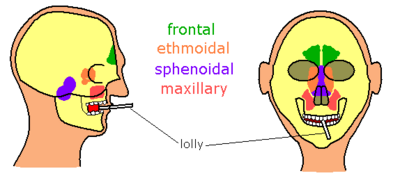Nasal cavity
Structure and Function
Structure
The nasal cavity extends from the nostrils in the front to the choanae (the two passageways down to the pharynx) behind. It is divided into right and left halves by the nasal septum.
The meati drain into the paranasal (next to nose) sinuses:
- Spheno-ethmoidal recess -> sphenoidal air sinus.
- Superior meatus -> ethmoidal sinus.
- Middle meatus -> maxillary sinus.
- Inferior meatus -> nasolacrimal duct (the duct that drains away tears-not the same as the tear duct).
Functions:
- Provides air supply and air conditions.
- Collects moisture.
- Makes a pleasing voice by resonance.
- Anti viral and anti bacteria.
- Moves mucous posteriorly to lubricate the pharynx.
- Filters particulates.
- Recirculation of air (probably).
- And olfaction (smelling stuff).
Arterial and Venous supply
Mostly supplied by the maxillary artery - but there is an anastamosis with the facial artery, which is why you get nosebleeds...
Nervous Supply
The olfactory nerves arise from the special olfactory (sense of smell) cells in the olfactory mucous membrane. They ascend through the cribriform plate to reach the olfactory bulbs in the brain.\\
Lymph
Mostly drains to the upper deep cervical nodes.
Histology
Most of the nasal and paranasal sinus cavities contain repiratory epithelium, that is pseudo-stratified columnar ciliated epithelium with many goblet cells (mucus producing). This respiratory epithelium continues down the whole respiratory tract.
Respiratory mucous membrane, lines the lower part of the cavity. Its function is to warm, moisten and clean inspired air:
- The warming is accomplished with the presence of a plexus (collection) of veins in the submucous connective tissue (which is why you bleed so much when you get a nose bleed).
- The moisture is from the mucus production of mucus secreted by mucous glands and goblet cells.
- The cleaning is by the moist sticky surface of the mucous membrane, which the particles stick to. The contaminated mucus is moved backwards by the cilia to the pharynx where it is swallowed.
Clinical Conditions
Epistaxis
Nosebleeds are a pretty common condition. Its generally caused by pickin' at yer hooter, in which case you treat it with cauterisation (burning the vessels closed). It can be a sign of hypertension also - I saw a guy in hospital who had one that just kept gushing for about 6 hours, and was potentially life threatening. Treat the underlying hypertension to stop that one.
Septal Breakdown
Cocaine use. ##not finished##
Foreign bodies
Common in children. The shape of the folded shelflike conchae make lodging balloons, peas, small toys, razorblades and umbrellas relatively easy. Always suspect foreign bodies when you are dealing with children, or with people from universities, since both are liable to put things in their mouths without really thinking about the consequences (case in point, food from Millenium/Food Station).
Rhinitis
Typical stupid medicine language for a cold. You can get the one caused by colds, or allergic rhinitis, which has an atopic (allerigic) association.
Sinusitis
Inflammation of the paranasal sinuses. Its generally caused by a virus first, and then followed by a bacterial infection like streptococcus pyogenes, pneumoniae or aureus. Either acute or, if the attacks do not recover or are repeated, chronic. If the drainage orifice of the sinus is blocked by inflamed swollen mucosa, an abscess may follow. From this you can get meningitis or a cerebral abscess. The maxillary sinus is very prone to infection because its drainage hole is at the top, so can only drain once the sinus is already full of fluid.
Tumours
Very rare. If it comes up we are all screwed, so it'll be fine.
